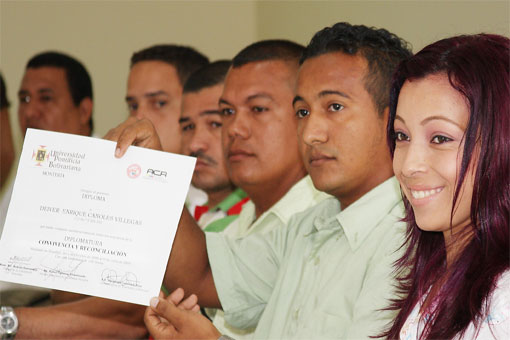After more than half a century of conflict, efforts to disarm, demobilize and reintegrate Colombia’s warring groups are just beginning to take hold. While a few small left-wing guerrilla groups were demobilized in the 1990s, successful reintegration of thousands of ex-combatants—most of them right-wing paramilitaries—into peaceful society has remained elusive. But that seems to be changing.
Reintegration involves providing ex-combatants with the educational, material and personal tools to become citizens and gain sustainable employment and income. It is a social and economic process with an open-ended time frame. Because it’s so specialized, it mostly takes place at the local level.
Between 2003 and 2006, individual demobilizations were the responsibility of the Programa para la Reincorporación a la Vida Civil (Program for Reincorporation into Civilian Life—prvc), operated by the Ministry of the Interior. Group demobilizations, involving over 31,000 paramilitaries, were the result of peace agreements reached by the national government, coordinated by the Oficina del Alto Comisionado para la Paz (Office of the High Commissioner for Peace—oacp). These agreements focused on returning the combatants to their hometowns and providing financial subsidies for two years—ranging from $210 to $420 monthly—to enable short-term financial sustainability. The oacp, based in Bogotá, provided an efficient, centralized management system, but it largely ignored other social factors such as creating community and family support networks, sustainable employment and the institutional capacity that would make such demobilizations successful. As a result, many former paramilitaries simply continued their criminal behavior and created what are now known as “emerging criminal bands” (bandas criminales emergentes—bacrim).
As demobilizations increased toward the end of 2006, the government realized that permanently addressing the needs of ex-combatants required a deeper commitment. The High Advisory Office for the Reintegration of Persons and Groups in Arms, a specialized administrative department created for this purpose, shifted the focus from reinsertion to reintegration.
The result was a decentralized system operating from more than 31 service centers throughout the country. Teams of professionals offered psychosocial advice, promoted further education, and provided job training, legal advice, and employment and entrepreneurial support. There were also political changes as the government signed various bills to provide support for communities that receive ex-combatants and for youth violence-prevention programs.
The change of government in 2010 brought an opportunity to further define this office. Under its expanded role, it was renamed the Agencia Colombiana para la Reintegración (Colombian Agency for Reintegration—acr) and charged with designing, coordinating and implementing the nation’s demobilization and reintegration policy.
In that role, the acr has developed a long-term reintegration policy that emphasizes community development, social services, coexistence, and peace-building. Key to the policy’s success is not only the development of job skills but also reconciliation in the communities that receive demobilized former combatants.
Successful reintegration is a long-term process, and it requires resources. On average, the successful reintegration of an ex-combatant takes between six and seven years and involves an investment of around $10,000 per person. Yet it’s a small price to pay when weighed against the economic impact of long-lasting, sustainable peace. One conservative estimate claims that ending the conflict and healing civil society could increase gdp by 2 percent per year1—more than making up for the cost.
The Colombian government finances 95 percent of the costs. However, public and private companies have also contributed technical expertise and financial support. More than 115 multinational corporations and local companies are providing employment and training opportunities to ex-combatants, along with project financing.
As of 2013, nearly 6,000 ex-combatants have received high school degrees. Nearly 29,000 are now incorporated into the financial system with bank accounts, health insurance and pension plans. And over 8,000 have started a business with an initial investment by the acr. A peace agreement would further increase the number of people in the reintegration process; but even without such an agreement, individual demobilizations are up by 25 percent so far this year.
The rate of recidivism into illegal armed groups is negligible—around 1 percent—but the rate of individuals sliding back into criminal activity is currently around 20 percent. That still compares favorably to the rate of recidivism in the Colombian justice system of over 70 percent. The figures show that a truly holistic approach to reintegration that addresses multiple dimensions of creating law-abiding and productive citizens—from education, health, housing and employment to personal security, psychosocial support and community relations—can lay the foundation for sustainable peace in Colombia.
The challenges are still formidable. It is difficult to remove the stigma of violence and abuses associated with former combatants. Yet as more people successfully conclude the reintegration process with a commitment to living in peace, this stigma is bound to fade. Ensuring that Colombia’s long nightmare of violence is never repeated demands that we make that commitment.
1 Cárdenas, Mauricio. 2007 “Crecimiento económico colombiano: ¿cambio de suerte?” Working Paper Series, 002403, Fedesarrollo; Álvarez, S. A. Rettberg. 2008 “Cuantificando los efectos económicos del conflicto,” Colombia Internacional, No 67, Enero-Junio; and Kalmanovitz, Salomon(editor). 2010 Nueva historia económica de Colombia.





